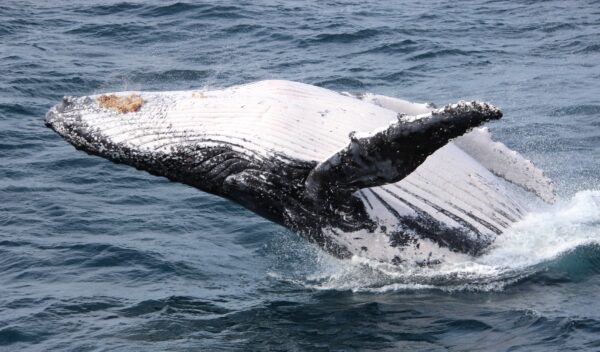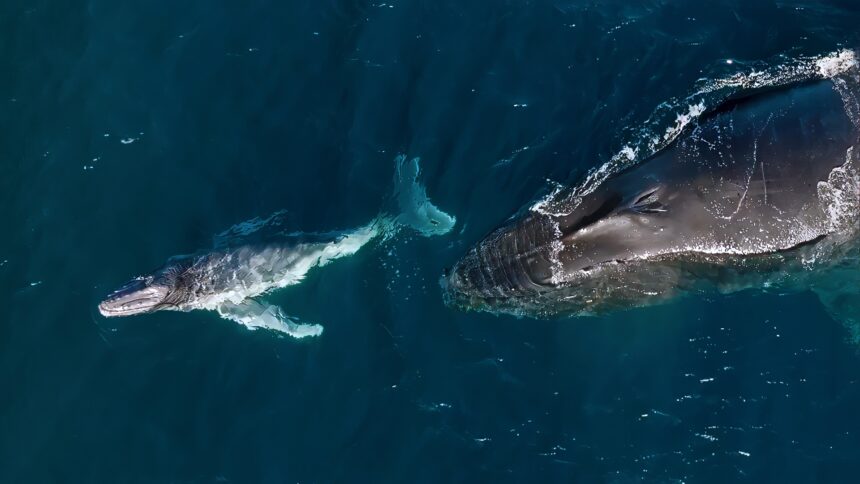The UNSW-led study took a look at more than 200 sightings of humpback calves filed by whale watchers, the public and government agencies from Queensland to Tasmania and to New Zealand’s South Island.
“Historically, we believed that humpback whales migrating north from the nutrient-rich Southern Ocean were travelling to warmer, tropical waters such as the Great Barrier Reef to calve,” says lead author Jane McPhee-Frew, a UNSW PhD candidate and whale-watching skipper.
But after an encounter with mother and calf in Newcastle Port in 2023 (the world’s largest coal export port), she and research colleagues started to take a closer look.
They noticed that sightings of calves were coming in from increasingly southern latitudes; a third dated back to 2016 but most were from 2023 and 2024.
“I was working part-time as a skipper on a whale-watching boat in Newcastle when I first spotted a calf in the area,” McPhee-Frew explains.
“It seemed out of place. The calf was tiny, obviously brand new. What were they doing here? But none of my tourism colleagues seemed surprised.
“This sparked a conversation with my research colleagues, and we realised there was a gap between scientific literature and sightings,” McPhee-Frew says.
She says the reported sightings came from the bottom of Tasmania, southernmost points of Western Australia and to the South Island of New Zealand.
She scoured historical records, including 19th Century whaling logbooks and accounts from expeditions like Captain Scott’s Terra Nova. Within these texts were sightings of mothers with calves at similar latitudes to those now reported.
She says this information about breeding patterns was likely not seen for decades as humpback populations were so low after industrial whaling stopped. They were once close to extinction in the 1960s but thanks to greater protection and conservation efforts, they number around 50,000, the UNSW says.
The discovery of baby humpbacks born so far south of the tropics may be new but the behaviour itself may not; it’s probably just newly visible, McPhee-Frew says.
This behaviour may also only just be coming into view “with more eyes than ever before looking at the water with technology like drones and with activities like whale watching”.
Government agencies, whale watching operators and social media are also helping to share images and information about the whales.
RISKY WATERS FOR CALVES
“It’s not just the sightings themselves that are important,” McPhee-Frew says.
“The pattern we’re seeing is mother whales with calves travelling through some of the busiest shipping lanes and urbanised regions.
“This means these vulnerable animals are exposed to risks like boat strikes, entanglements, pollution – and just general public unawareness.”
McPhee-Frew says the study highlights is the critical need for greater awareness to protect the newborn whales throughout their winter journey north which could span more than 2300km.
“Regardless of the health of population now, we can’t be in a situation where we’re putting any age of whales – especially baby whales – in a situation where they’re getting caught in nets, being exposed to chemicals, being hit by boats and being harassed,” she says.
Co-author Professor Tracey Rogers, also from UNSW, also points out that calves are not as strong as adult whales.
“Mums with newborns swim much more slowly,” she says.
“Newborns are like Great Dane puppies. They have long, enormous fins that they need to grow into and they’re not very strong swimmers so they rest a lot of the time on their mum’s back,” she says.
“Imagine giving birth off Hobart and then swimming up the coast.
“It’s heartbreaking to think of these young whales travelling through busy ports and dangerous shipping lanes with those long, clumsy fins.
“It’s not just happening here in NSW – this is off WA, Victoria, Tasmania, New Zealand – it’s something we just didn’t know before.”

KEEPING A SAFE DISTANCE
“The legislation to protect humpback whales, including mothers and calves, is already in place across all states,” says Dr Adelaide Dedden from the NSW National Parks and Wildlife Service, which collaborated with the UNSW scientists for this study.
“But we do have a gap in public awareness, particularly among recreational water users,” she says.
“People need to be aware that calves are being seen not just on the southern migration but also on the northern one.”
Close-ups with baby humpbacks are rare and rely on the whales approaching vessels out of curiosity, not pursued by it.
“Humpbacks are charismatic and curious,” Dr Dedden says. “They’re going to want to come and check out the boat.”
She says the guidelines are to maintain a 100m distance from adult whales and 300m from mother-calf pairs.
“We’ve been working hard to get this message out to the public and encourage boaters, surfers, kayakers and jet-ski operators to be aware of these guidelines,” Dr Dedden says.
“The excitement and curiosity around whales are contagious,” McPhee-Frew says.
“We’ve built a huge repository of data just by encouraging the public to share observations.”
QUESTIONS REMAIN
McPhee-Frew says the question remains of why humpback mothers use the ‘humpback highway’ to travel north after birth because “in the tropics, there’s really no food for them”.
She says rather than hold a strict view of migratory patterns with fixed endpoints, the focus is shifting to how humpbacks use different marine environments on their journey.
“We still have a lot to learn,” says McPhee-Frew.
“But you know what? It’s such a privilege to see whales. It is such a fantastic aspect of living in Australia.
“We just need to follow the rules so everyone can enjoy.”






